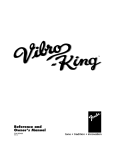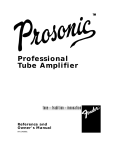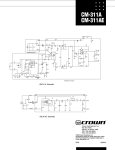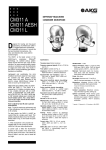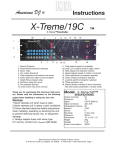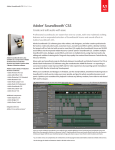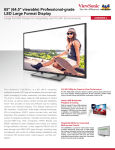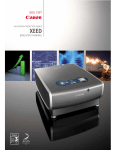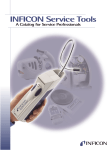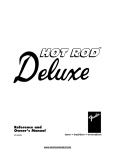Download Fender MUSICAL INSTRUMENTS Musical Instrument User Manual
Transcript
Amp Can™ A PRODUCT OF: FENDER MUSICAL INSTRUMENTS CORP. CORONA, CA USA Reference and Owner’s Manual P/N 050540 REV B AMP CAN SPECIFICATIONS DESIGNATION TYPE PR 327 PART NUMBER 022-1270-000 022-1200-000 022-1230-000 022-1240-000 022-1260-000 POWER OUTPUT 14.5 W into 4 Ω @ 5%THD with fresh battery INPUT IMPEDANCE > 1 MΩ both channels INPUT SENSITIVITY GUITAR 500 µV@ 1 kHz - gain switch in 20 mV @ 1 kHz - gain switch out INPUT SENSITIVITY MICROPHONE 5.7 mV, 1 kHz Wishing you years of enjoyment and a heartfelt thank you, SPEAKER 4 Ω, 30 W Special Design 6” speaker w/16 oz. magnet and paper coil former (P/N 050543) Bill Schultz Chairman Fender Musical Instruments Corporation DIMENSIONS Height: 8.75 in Width: 7.75 in Depth: 6.75 in Fender Musical Instruments 7975 North Hayden Road, Scottsdale, Arizona 85258 U.S.A. Since 1946, Fender realized the importance of your amplifier. You see, your amplifier is more than just a combination of dials, wires and speakers. Your amplifier is a musical instrument. And like any fine musical instrument, it should be treated with special care and attention to detail. At Fender, we know what building guitar amplifiers is all about. For over half a century, we have been designing and producing some of the world's best amplifiers helping shape the face of music. In fact, many of the world's most classic and best sounding amplifiers have proudly worn the Fender name. Whether you're after that classic Fender tone, a clean crisp sound for your Bass or Keyboard or the raw driving power of modern distortion, your decision to purchase a Fender amplifier is one you will appreciate with each passing note for years to come. WEIGHT 13 lbs (100 (120 (240 (230 (230 V) V) V) Aust V) UK V) Euro 22.3 cm 19.7 cm 17.2 cm 5.9 kg Amp Can™ is a trademark of FMIC. Fender®, Tone-Master® and Twin Reverb® are registered trademarks of FMIC. Product specifications are subject to change without notice. 7 BATTERY CARE, Cont. TROUBLESHOOTING IMPORTANT: DO NOT DISPOSE OF THE BATTERY IN THE GARBAGE. For proper disposal of the lead-acid battery, it should be taken to a lead-acid battery recycle and disposal center, such as an automobile service center, to avoid environmental contamination. If your Amp Can is set up but does not function, check the following items: • Is your Amp Can’s battery properly charged? • Are your Amp Can’s control knobs turned above their minimum positions? • Is the volume control on your guitar turned up? • Is your microphone on? • Is the instrument properly plugged into the amplifier? As a final note, playing your Amp Can with the charge adapter attached and plugged in will not damage the unit, however, a slight hum will occur. Additionally, playing your Amp Can with the charge adapter attached will significantly increase playing time, however, the battery will only charge with the power OFF. Eliminate any effects pedals and try using another cord. COVERING CARE If after checking all of the above the amplifier is still not performing correctly, contact your nearest authorized Fender Service Center. Your Amp Can is covered in genuine Tolex for long life and lasting good looks. To clean the Tolex covering, use a damp sponge with a light soapy water solution. Avoid spilling liquids on the operating surfaces, grill, volume and tone controls, switches and speaker. ALWAYS make sure your Amp Can is OFF before cleaning or approaching it with fluids. While designed for portability, your Amp Can should be treated with care and kept clean and free of moisture. Sand, dirt, salt-water spray or similar debris can severely damage and corrode the internal circuit board, wiring and battery connections. To ensure safety and years of enjoyment, store and care for the Amp Can as you would any other musical instrument or guitar amplifier. THE FENDER AMP CAN™ Constructed from 1/2 inch (1.27 cm) PVC and HighImpact ABS Plastic for Long-Lasting Durability Your new Fender Amp Can is designed by the same Tone-Team that has created many other classic Fender amps: like the Tone-Master®, Twin Reverb® and the versatile Hot Rod Series. Built with care and attention to detail, the Amp Can is a great amp by any measure. 12V, 4.5 Amp Hour Rechargeable Sealed Lead Acid Battery provides 4 to 6 Hours of Power Designed for street musicians or anyone who needs a portable high quality amplifier, the Amp Can features convenient panel mounted controls and input jacks. Its 12-volt rechargeable battery provides the Amp Can with power for 4 to 6 hours per charge cycle. Input Channels for Guitar, Instruments and Mic with Individual Volume and Tone Controls Allowing the Input Channels to be Mixed Separately Aside from its portability, your Amp Can is like any other guitar amplifier. To ensure maximum safety and life from your Amp Can and its battery, please read through thoroughly and heed all safety warnings relating to your Amp Can. Rugged Steel Carrying Handle and Stand Allows the Speaker to be Angled for Optimum Sound Coverage Heavy Duty 6” 4Ω Paper Coil Former Speaker with 16 oz. Magnet for a Smooth Full-Range Sound Take the time to get to know each other... Tune-up, Plug-in and ...Play On! WARNING: -TO PREVENT DAMAGE, FIRE OR SHOCK HAZARD, DO NOT EXPOSE THIS UNIT TO RAIN OR MOISTURE. -USE OF A CHARGER OTHER THAN THE ONE SUPPLIED WITH THIS UNIT MAY RESULT IN RISK OF FIRE, ELECTRIC SHOCK OR INJURY. -NO USER SERVICEABLE PARTS INSIDE, REFER SERVICING TO QUALIFIED PERSONNEL ONLY. 6 3 AMP CAN BATTERY CARE AND MAINTENANCE AMP CAN CONTROL PANEL B C D E A F K G I H A. GUITAR INPUT - Plug your guitar in here. This is a 1/4 inch, high impedance input for electric guitars. B. GUITAR VOL loudness of the channel. J F. POWER - This switch is used to turn the unit ON and OFF. When your Amp Can is OFF, no power is drawn from the battery. If the adapter is connected, the charging circuitry is enabled . - Adjusts the GUITAR input G. MIC INPUT - This is a 1/4 inch, high impedance input for a microphone or acoustic-electric guitar. C. GAIN - This “push-push” switch selects between low and high gain for the guitar input channel. For high gain, the switch should be pushed in. H. MIC VOL - Adjusts the loudness of the MIC input channel. D. GUITAR TONE - Adjusts the tone and brightness of the guitar input channel. 10 is the brightest setting becoming progressively less bright as the dial is rotated towards 1. I. MIC TONE - Adjusts the tone and brightness of the mic input channel. 10 is the brightest setting becoming progressively less bright as the dial is rotated towards 1. E. POWER LED - Illuminates green when your Amp Can is on. If the LED glows red momentarily while playing, this is an indication that it is almost time to recharge the battery. Once the power LED stays red, the battery should be recharged. J. CHARGER - The external “wallmount” adapter connects here to charge the battery. K. CHARGE LED - Illuminates green when your Amp Can’s battery is charging. 4 Your Amp Can is powered by a 12 volt, 4.5 amp-hour, sealed lead-acid battery. It is very powerful and has much more in common with a car battery than it does a flashlight battery. With proper care and maintenance and under normal operating conditions, the battery could last 3 to 5 years and provide your Amp Can with power for 4 to 6 hours per charge cycle. It is important to remember that the longer your Amp Can is played after the LED turns red, the longer it will take to recharge the battery. If your Amp Can is played until it stops operating, it may take 72 hours or more to completely recharge. Moreover, allowing the battery to deeply discharge will significantly lessen the battery’s life span. To recharge the battery, simply connect the “wall-mount” adapter to the charger input on your Amp Can (item K page 4), then plug it into a wall outlet. Be sure your Amp Can is in its upright position before recharging. Do not leave the charger plugged in for more than 72 hours. In the short term, leaving the charger plugged in for more than 72 hours will not damage your Amp Can or its battery, however, repeated “over charging” of the battery will in time decrease its efficiency and storage capacity. Like a car battery, non-use and improper storage of your Amp Can will significantly lessen the battery’s ability to hold a charge. Thus, your Amp Can should be stored indoors at room temperature and played as often as you would like. (Frequent use of your Amp Can is actually good for the battery!) It is best to recharge your Amp Can after each use. If your amp is stored for an extended period of time, the battery should be recharged every 6 months otherwise permanent loss of capacity may occur. Upon removing your Amp Can from its packaging, the Amp Can’s battery should be allowed to charge overnight (approximately 16 hours) to ensure maximum battery life. CAUTION: DO NOT CHARGE OR STORE THE BATTERY IN TEMPERATURES ABOVE 122O F (50O C) OR DAMAGE MAY RESULT. Like any battery, extreme heat will significantly lessen your Amp Can’s battery life. It is best to recharge and store your Amp Can indoors and at room temperature. When your Amp Can is turned on, the power LED glows green indicating the battery is charged. As the amp is played and its battery power utilized, the power LED will in time begin to momentarily flash red indicating the battery will soon lose its charge. Once the power LED stays red, the battery should be recharged immediately. Recharging the battery takes approximately 12 to 16 hours. If after normal use and maintenance the playing time drops below 2 hours or if the battery takes more than 24 hours to recharge, it may be time to replace the battery. Contact your nearest authorized Fender dealer for a replacement battery (P/N 050548). 5




